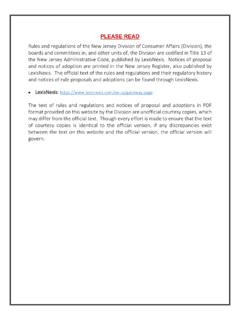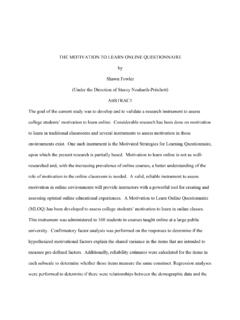Transcription of [NEW] ACR Practice Guideline for Imaging Pregnant or ...
1 The American College of Radiology, with more than 30,000 members, is the principal organization of radiologists, radiation oncologists, and clinical medical physicists in the United States. The College is a nonprofit professional society whose primary purposes are to advance the science of radiology, improve radiologic services to the patient, study the socioeconomic aspects of the Practice of radiology, and encourage continuing education for radiologists, radiation oncologists, medical physicists, and persons practicing in allied professional fields. The American College of Radiology will periodically define new Practice guidelines and technical standards for radiologic Practice to help advance the science of radiology and to improve the quality of service to patients throughout the United States.
2 Existing Practice guidelines and technical standards will be reviewed for revision or renewal, as appropriate, on their fifth anniversary or sooner, if indicated. Each Practice Guideline and technical standard, representing a policy statement by the College, has undergone a thorough consensus process in which it has been subjected to extensive review, requiring the approval of the Commission on Quality and Safety as well as the ACR Board of Chancellors, the ACR Council Steering Committee, and the ACR Council. The Practice guidelines and technical standards recognize that the safe and effective use of diagnostic and therapeutic radiology requires specific training, skills, and techniques, as described in each document. Reproduction or modification of the published Practice Guideline and technical standard by those entities not providing these services is not authorized.
3 2008 (Res. 26)* ACR Practice Guideline FOR Imaging Pregnant OR POTENTIALLY Pregnant ADOLESCENTS AND WOMEN WITH IONIZING RADIATION PREAMBLE These guidelines are an educational tool designed to assist practitioners in providing appropriate radiologic care for patients. They are not inflexible rules or requirements of Practice and are not intended, nor should they be used, to establish a legal standard of care. For these reasons and those set forth below, the American College of Radiology cautions against the use of these guidelines in litigation in which the clinical decisions of a practitioner are called into question. The ultimate judgment regarding the propriety of any specific procedure or course of action must be made by the physician or medical physicist in light of all the circumstances presented.
4 Thus, an approach that differs from the guidelines, standing alone, does not necessarily imply that the approach was below the standard of care. To the contrary, a conscientious practitioner may responsibly adopt a course of action different from that set forth in the guidelines when, in the reasonable judgment of the practitioner, such course of action is indicated by the condition of the patient, limitations on available resources, or advances in knowledge or technology subsequent to publication of the guidelines. However, a practitioner who employs an approach substantially different from these guidelines is advised to document in the patient record information sufficient to explain the approach taken.
5 The Practice of medicine involves not only the science, but also the art of dealing with the prevention, diagnosis, alleviation, and treatment of disease. The variety and complexity of human conditions make it impossible to always reach the most appropriate diagnosis or to predict with certainty a particular response to treatment. Therefore, it should be recognized that adherence to these guidelines will not assure an accurate diagnosis or a successful outcome. All that should be expected is that the practitioner will follow a reasonable course of action based on current knowledge, available resources, and the needs of the patient to deliver effective and safe medical care. The sole purpose of these guidelines is to assist practitioners in achieving this objective.
6 I. INTRODUCTION Radiation exposure to a Pregnant or potentially Pregnant patient from a medical Imaging procedure and the management of such patients are complex topics. Patients, their families, radiologists and physicians, or other medical practitioners who refer patients for Imaging procedures or perform Imaging in their own offices, are understandably concerned about the possible detrimental effects of radiation exposure to the developing embryo and fetus. This concern contrasts with medical concerns about the potential risks to a Pregnant patient when, out of unnecessary or inordinate concern over radiation, she forgoes a necessary Imaging procedure. Clearly, an appropriate benefit/risk perspective is necessary to properly care for the ill or injured Pregnant patient.
7 In recognition of the importance of this topic, the following citation will be added to all appropriate ACR Practice Guidelines and Technical Standards: For the Pregnant or potentially Pregnant patient, see the ACR Practice Guideline for Imaging Pregnant or Potentially Pregnant Adolescents and Women with Ionizing Radiation. ACR Practice Guideline Pregnant or Potentially Pregnant Patients / 23 Since there is no known threshold for some radiation effects (stochastic effects), it has been argued that there is no safe level of radiation exposure. By this rationale, nearly every human activity has no safe level. No safe level is a sweeping statement that applies only when no benefit is derived from an activity.
8 It is not applicable when benefits of an activity far exceed risk. For example, many people are exposed to naturally existing environmental radiation in excess of what others receive. This includes people who live at mountain elevations and others who frequently use air travel. These behaviors are considered beneficial to their lifestyle. Neither of these situations is considered inherently unsafe due to the extra radiation that results. Use of the term safe in any setting, clinical or nonclinical, must be understood within the context of benefit versus risk. Safety is a matter of taking appropriate actions to limit the risk to a level well justified by the benefit. To maintain a high standard of safety, particularly when Imaging potentially Pregnant patients, Imaging radiation must be applied at levels as low reasonably achievable (ALARA), while the degree of medical benefit must counterbalance the well-managed levels of risk.
9 This Guideline has been developed to provide current practical information to radiologists and other physicians and health care providers on developing and implementing policies for Imaging Pregnant and potentially Pregnant patients. Individual institutions and facilities should develop their own policies and procedures. As with all Imaging procedures, the specifics of an individual case must always be considered and may lead to the modification of even the most strongly suggested guidelines. Throughout this Guideline , the radiologic technologist is considered to be the person in the radiology department who is most likely to communicate with the patient about the potential for pregnancy.
10 Nurses, radiologist assistants, and receptionists might also do so. For example, a receptionist might provide the patient a questionnaire about her reproductive history that is to be completed before admission to the radiographic suite. Therefore, whenever this Guideline refers to technologists as responsible personnel for certain actions, it should be understood that others might share in or be assigned this responsibility. When managing the Pregnant patient, the role of the medical physicist is to estimate absorbed dose to the conceptus of a Pregnant patient from selected diagnostic or interventional procedures, either prospectively or retrospectively. The physicist also consults with the radiologist regarding risk associated with radiation and means by which this risk can be reasonably limited.

















